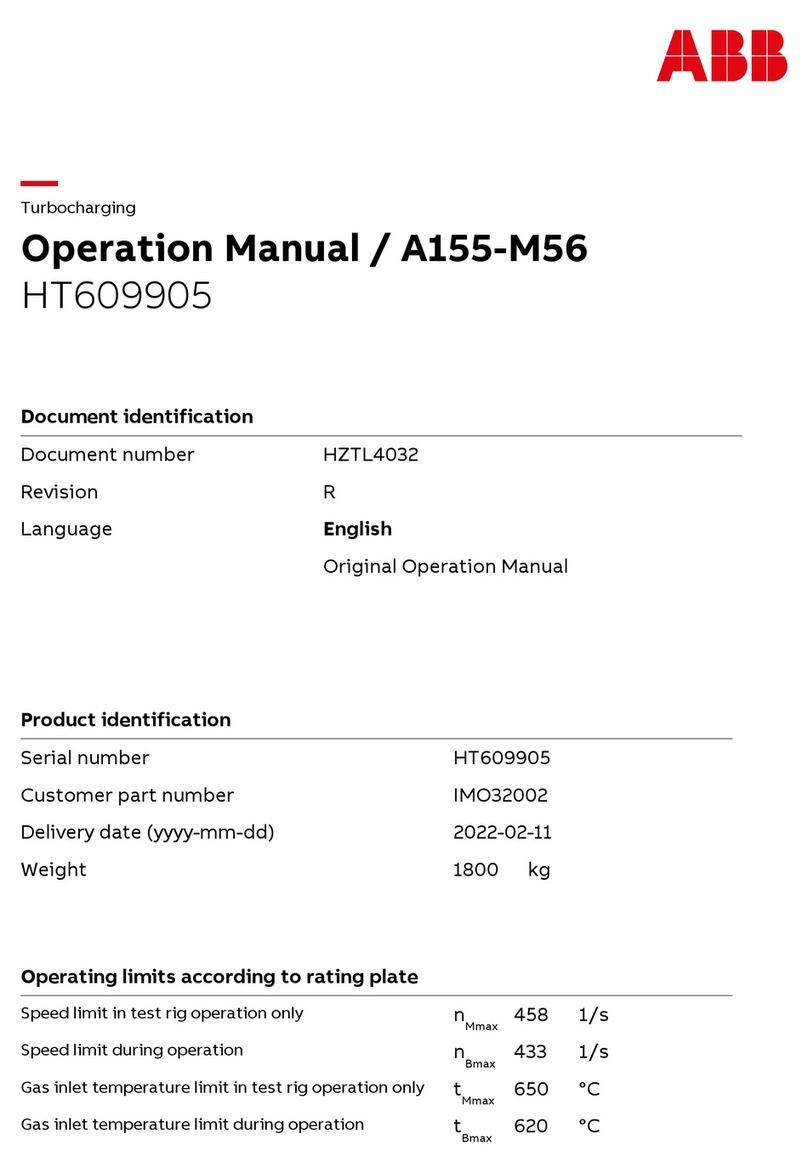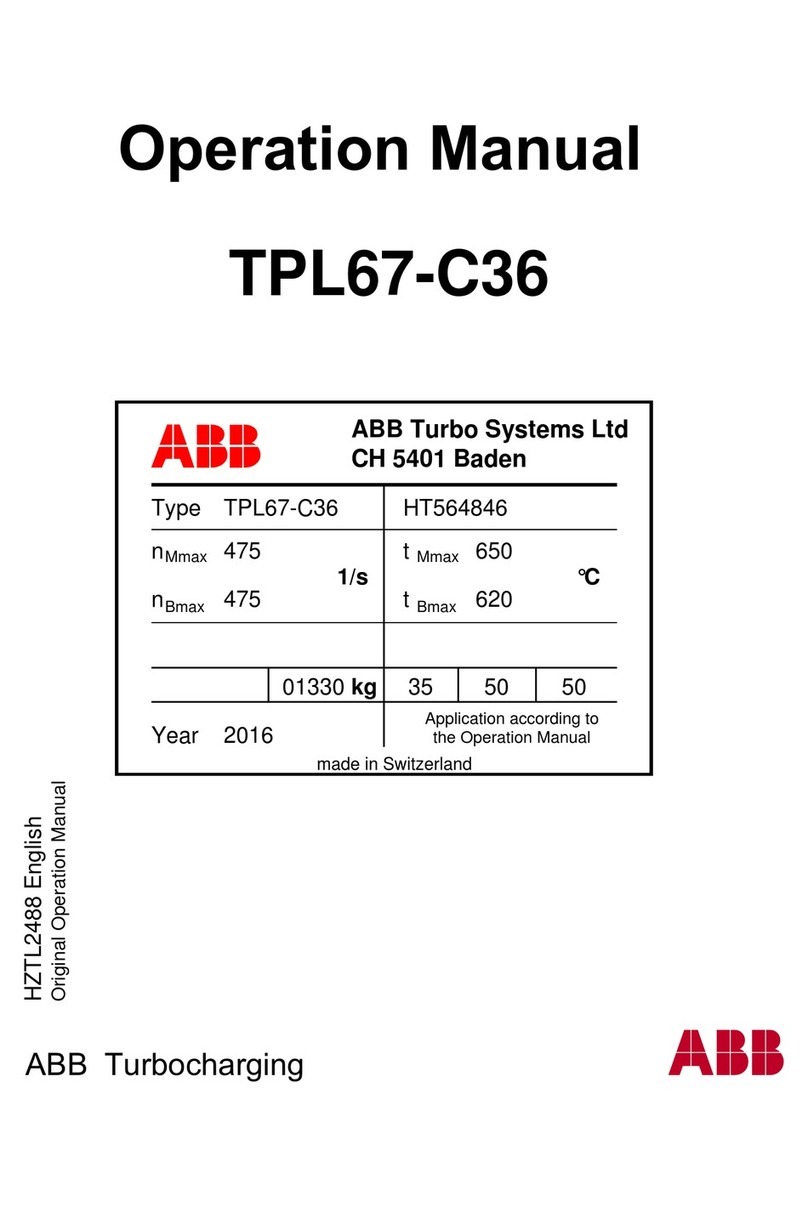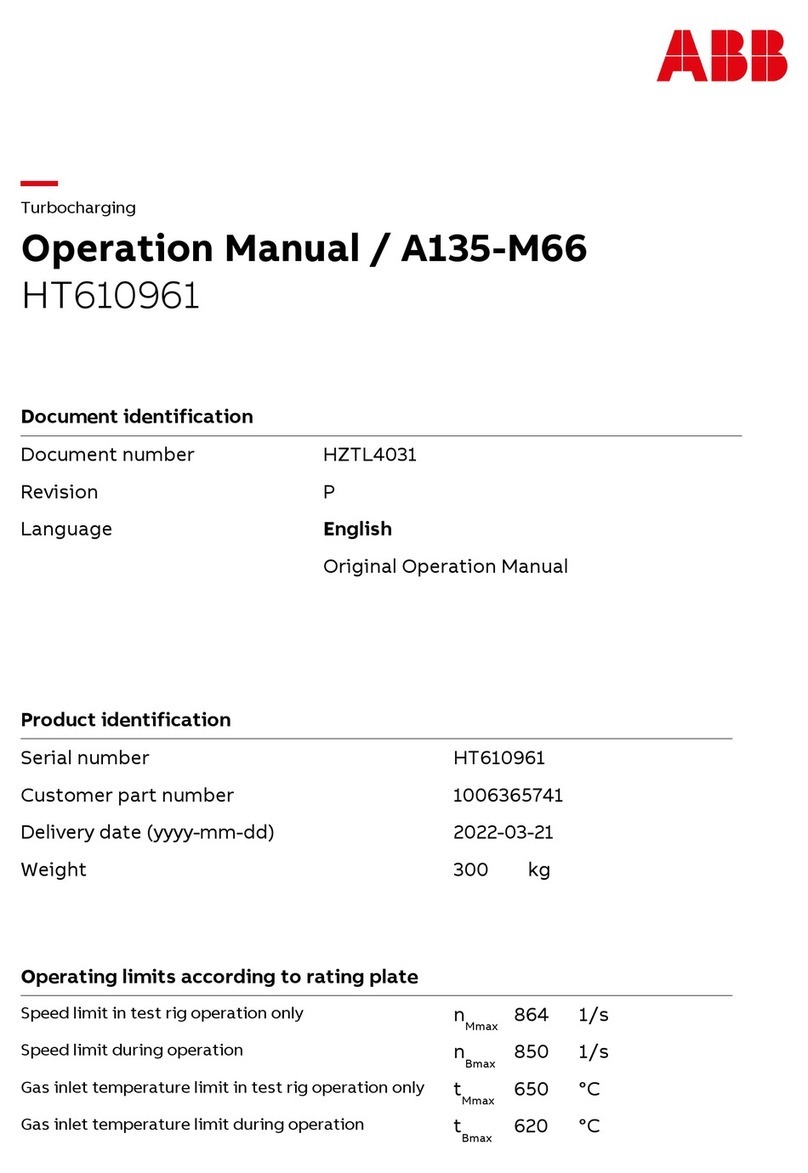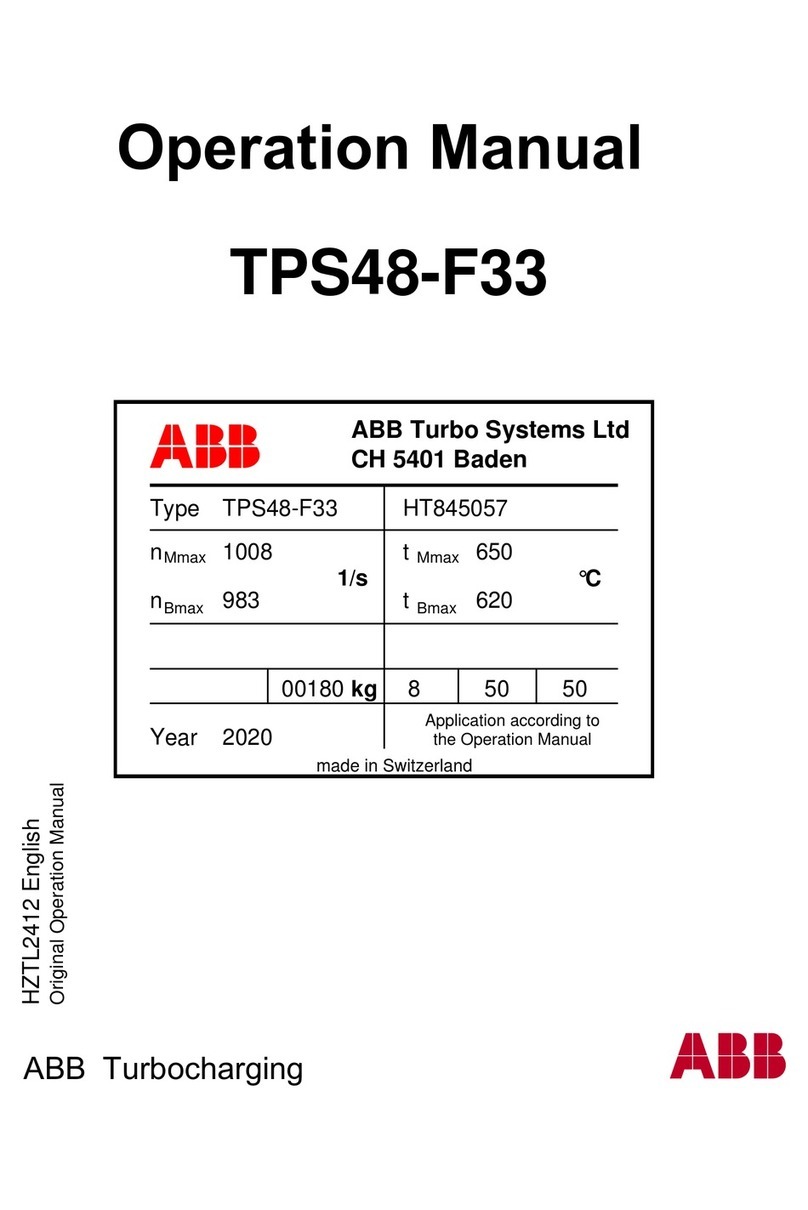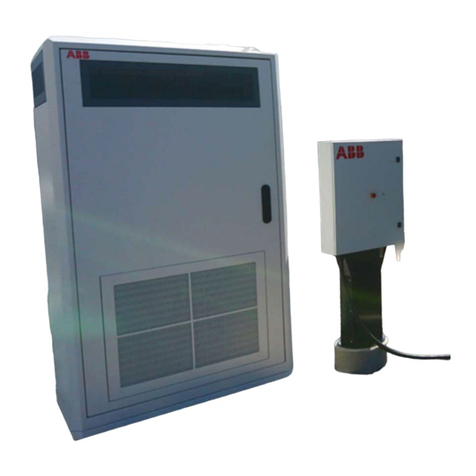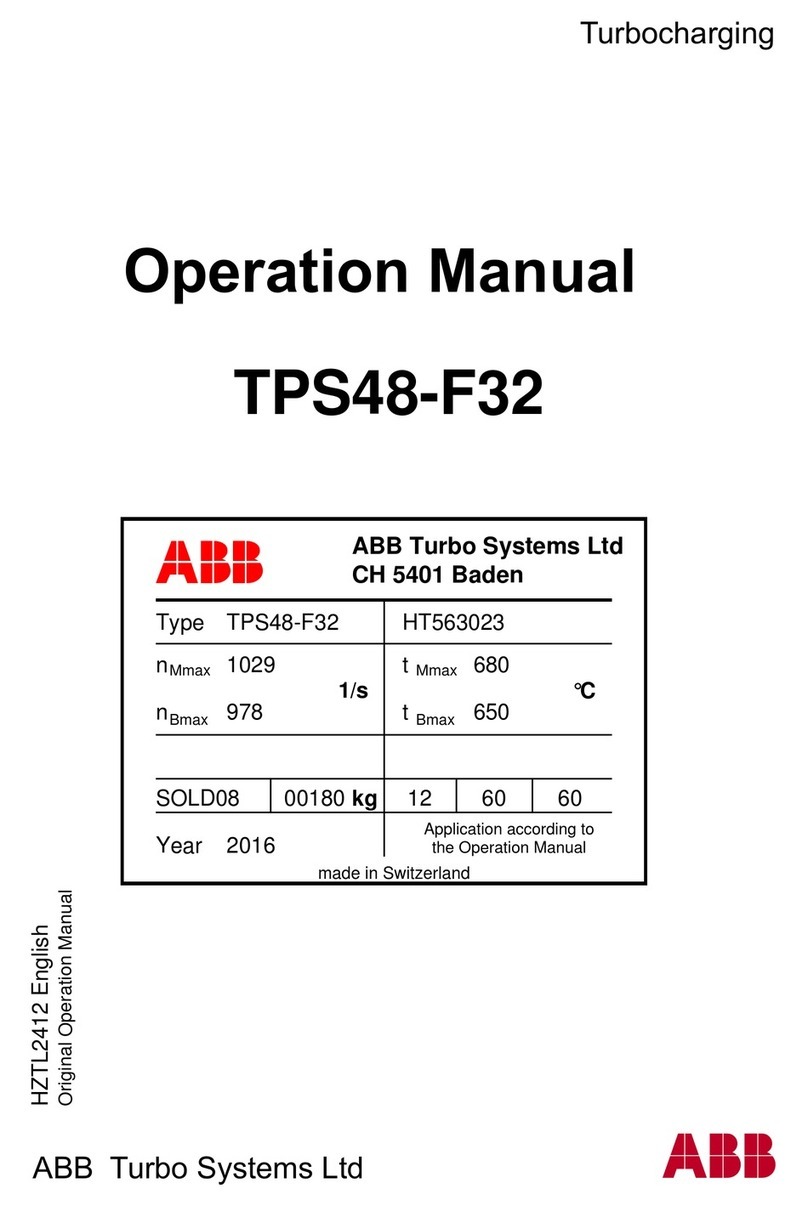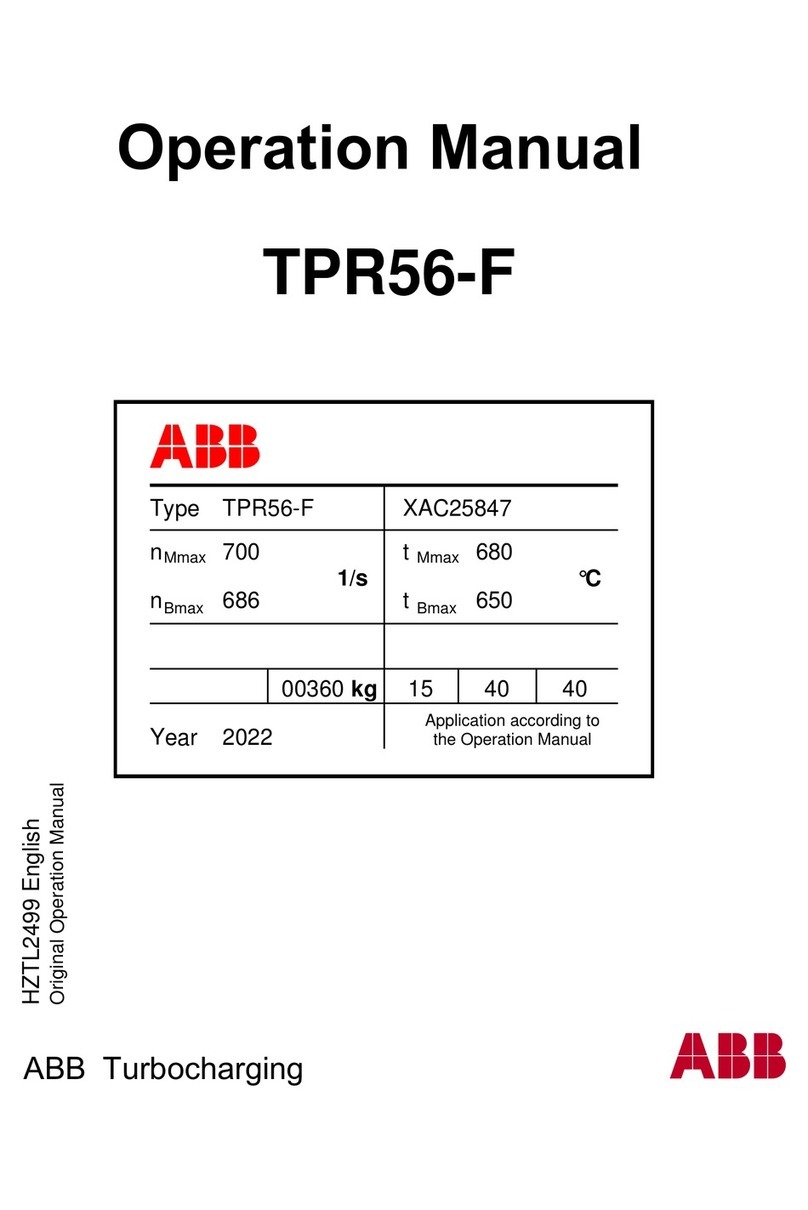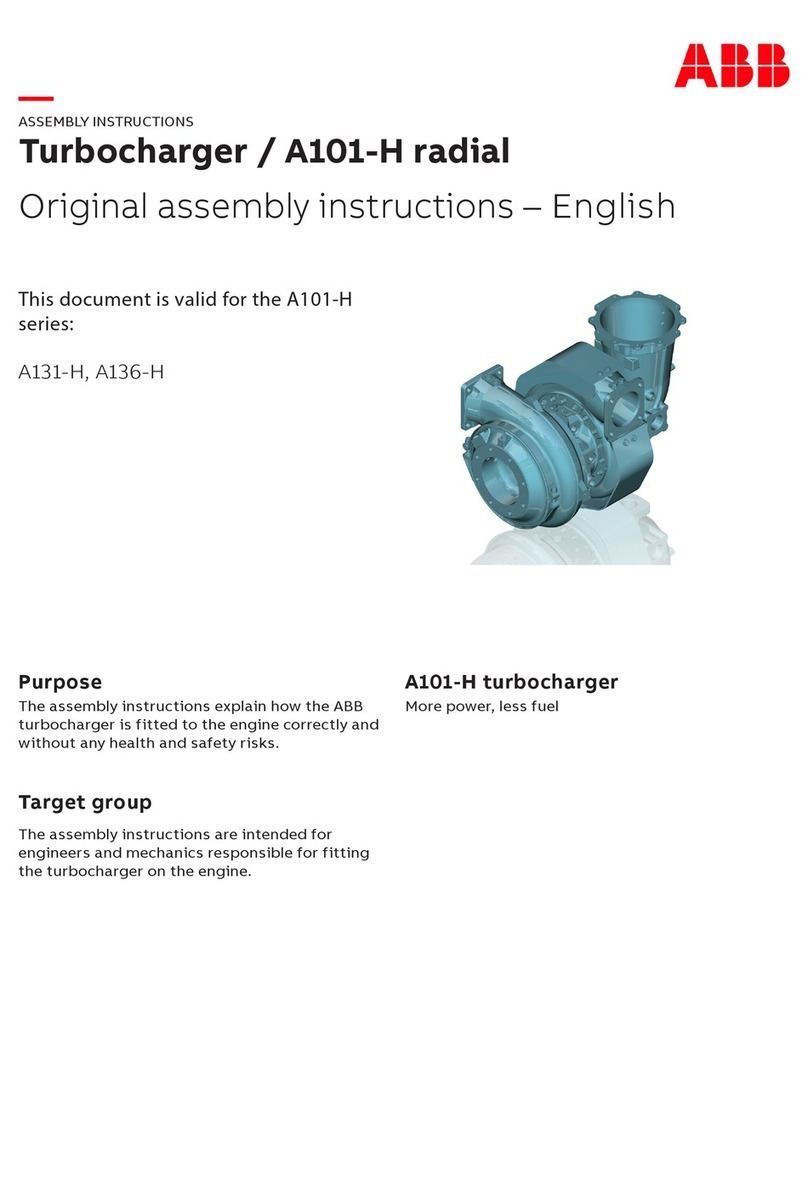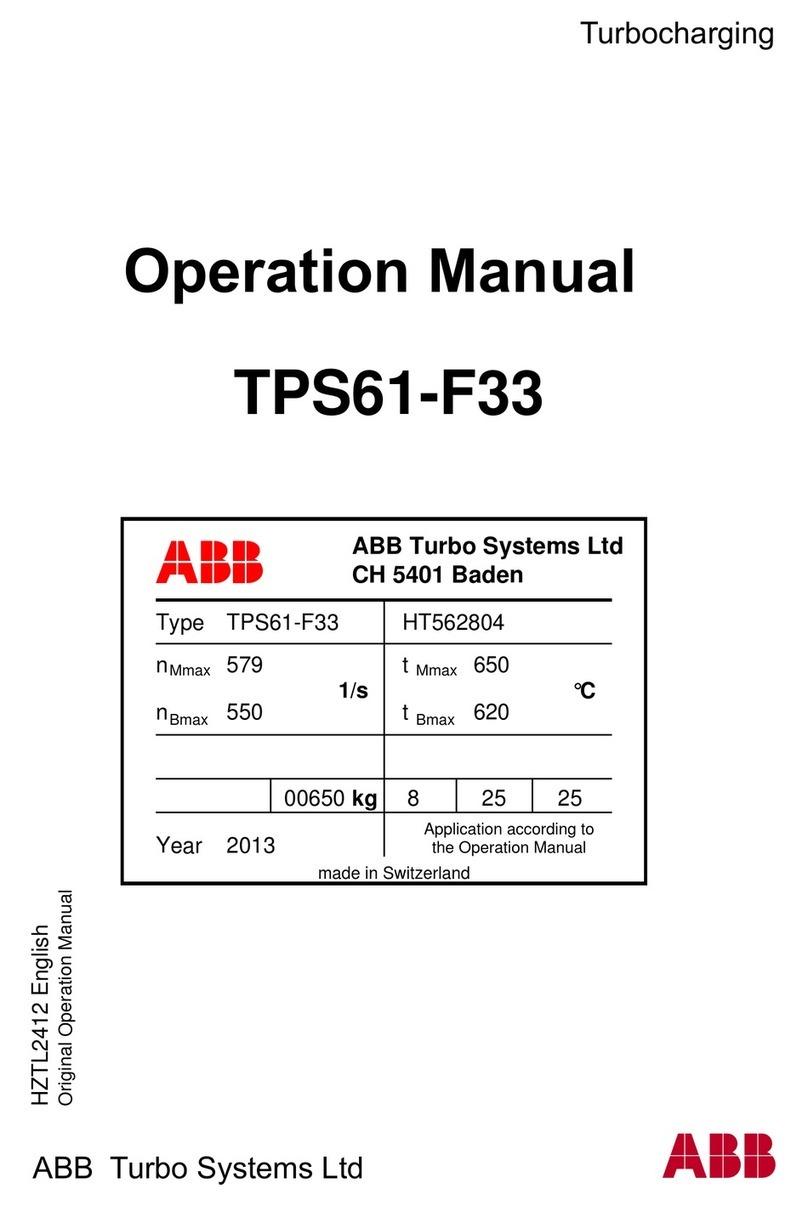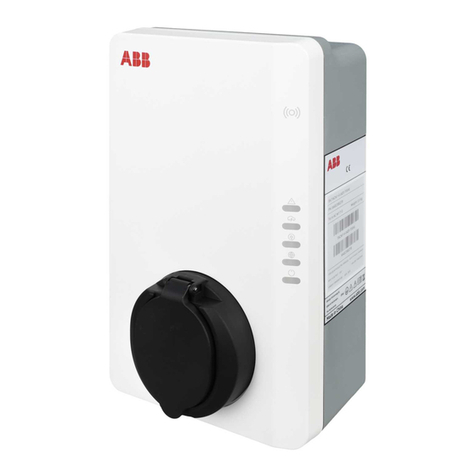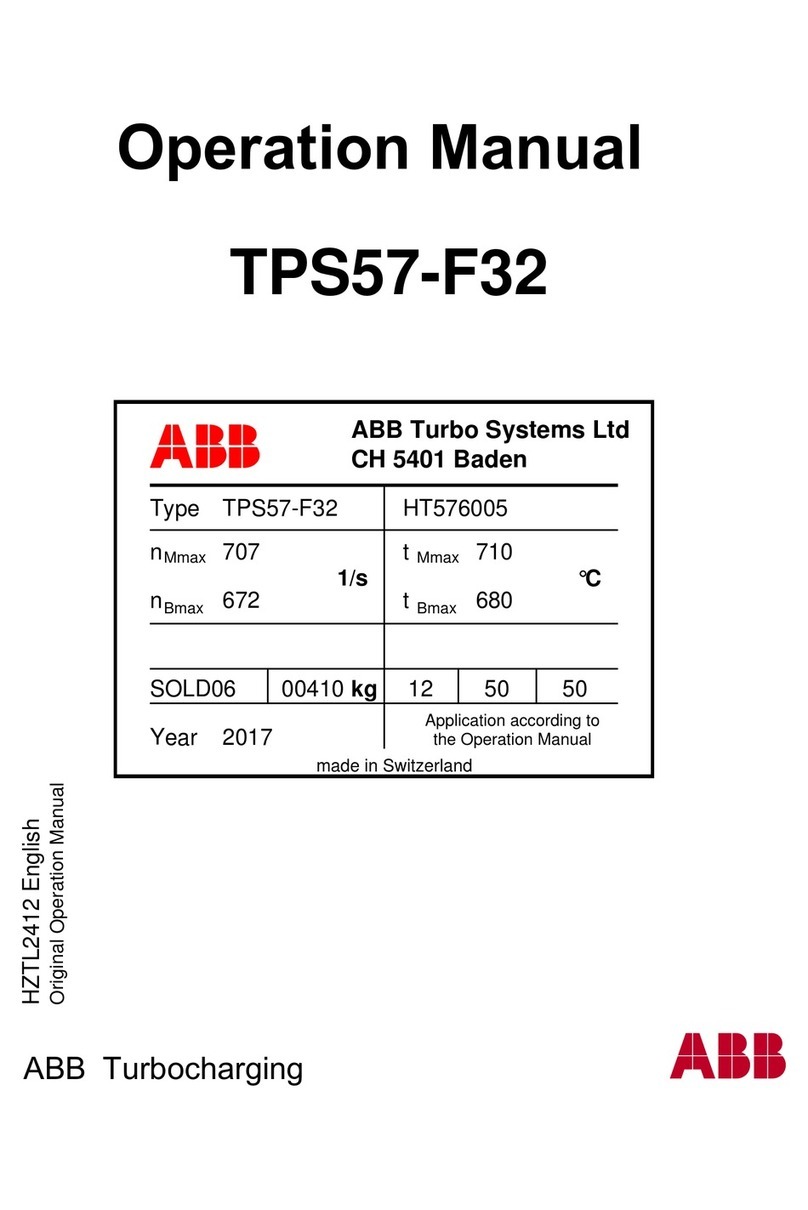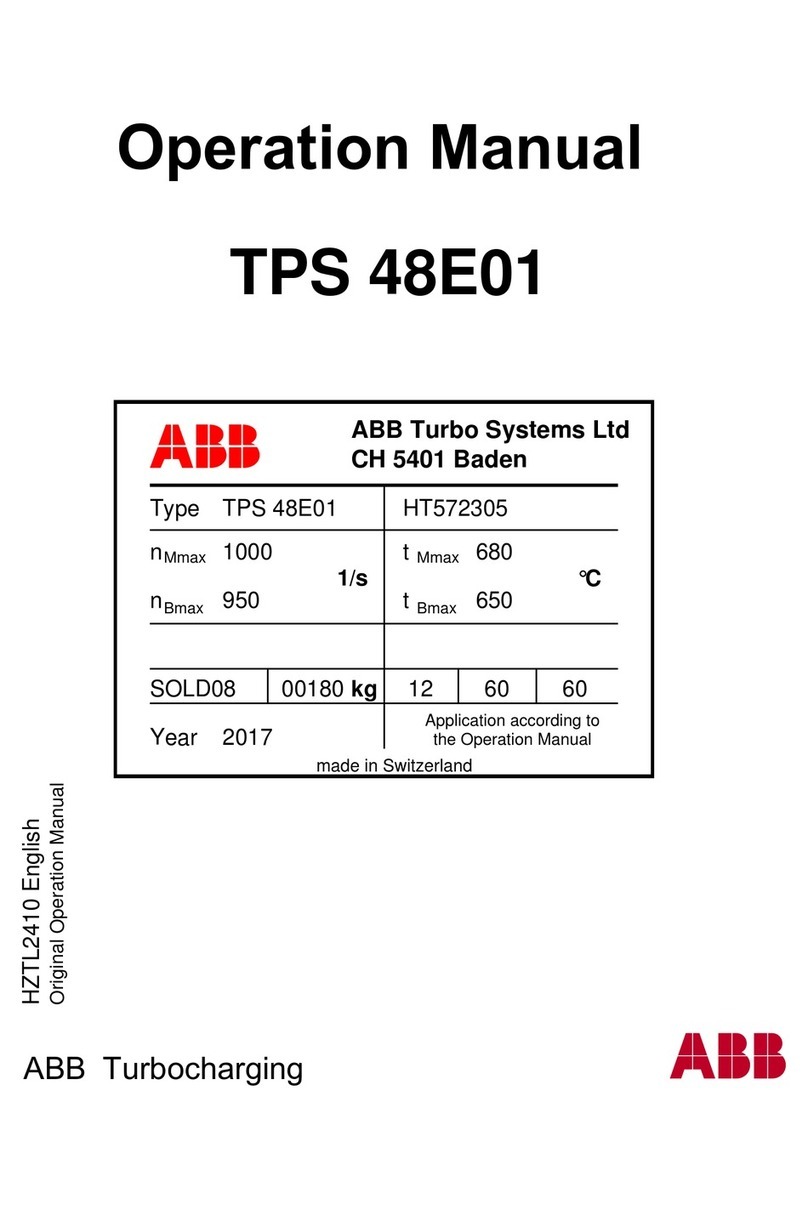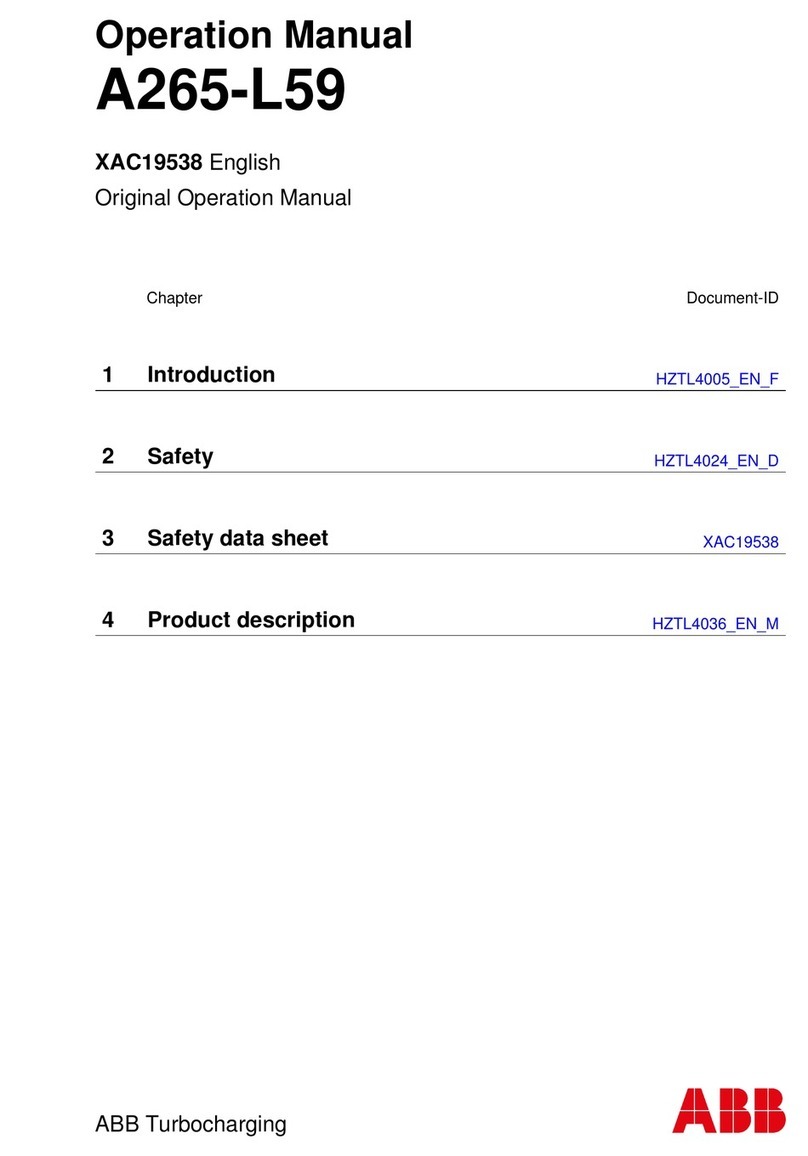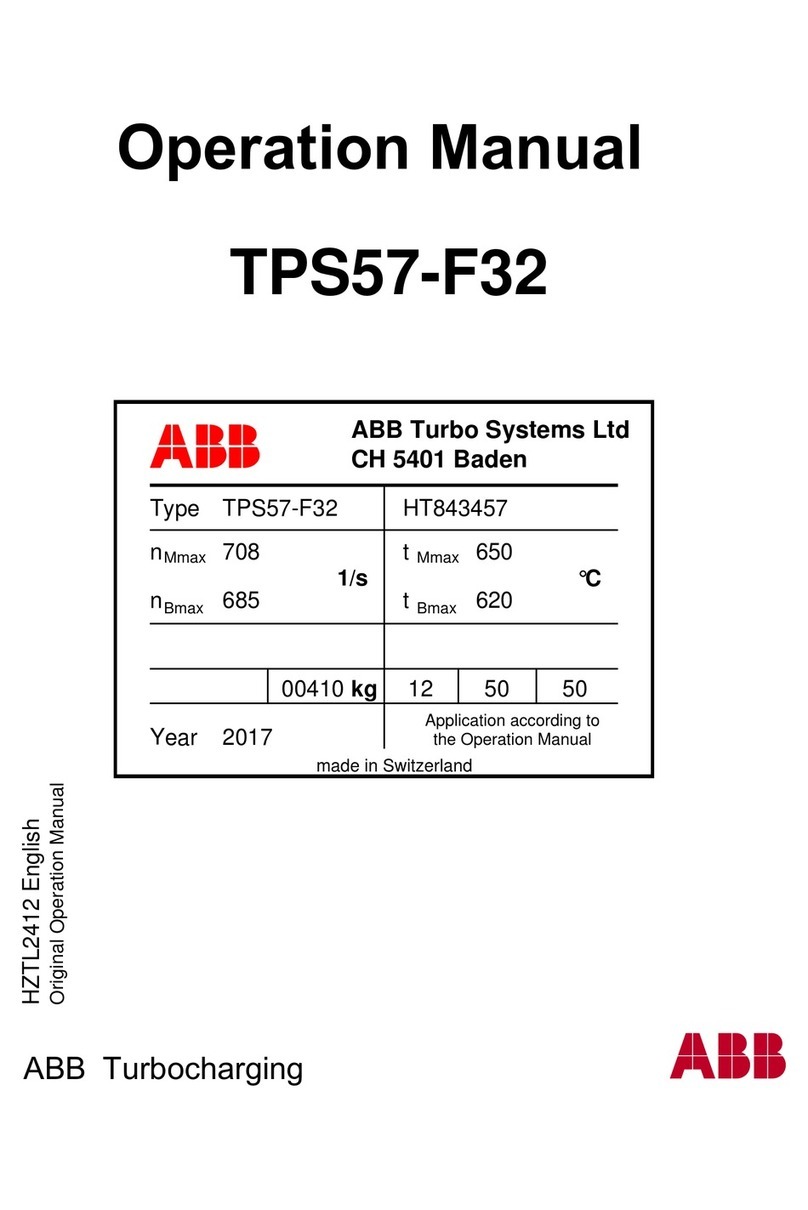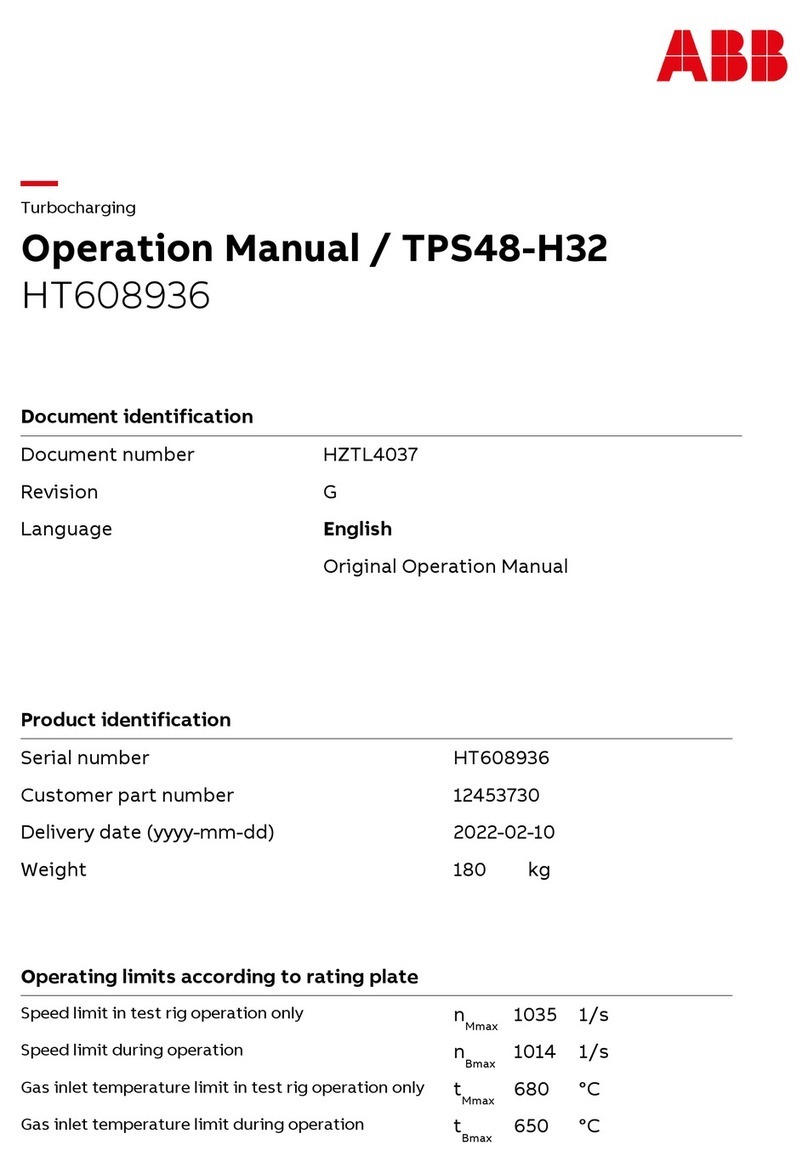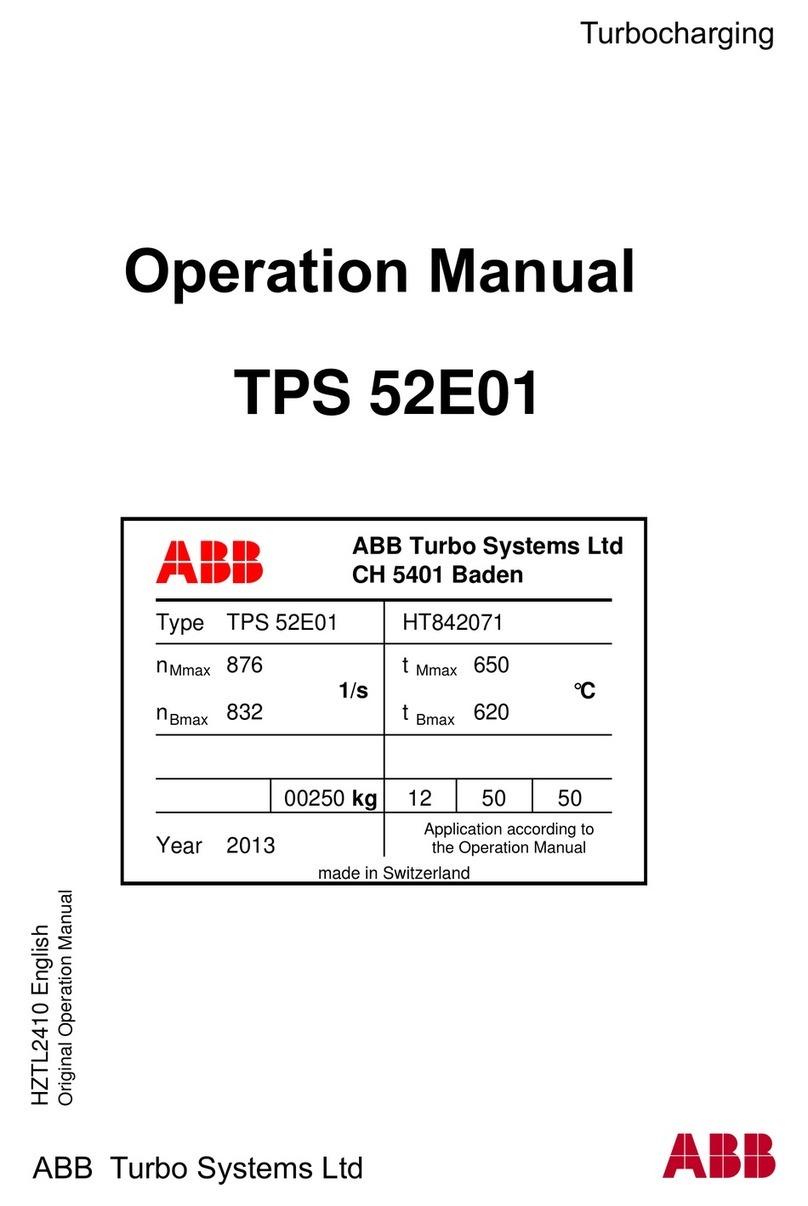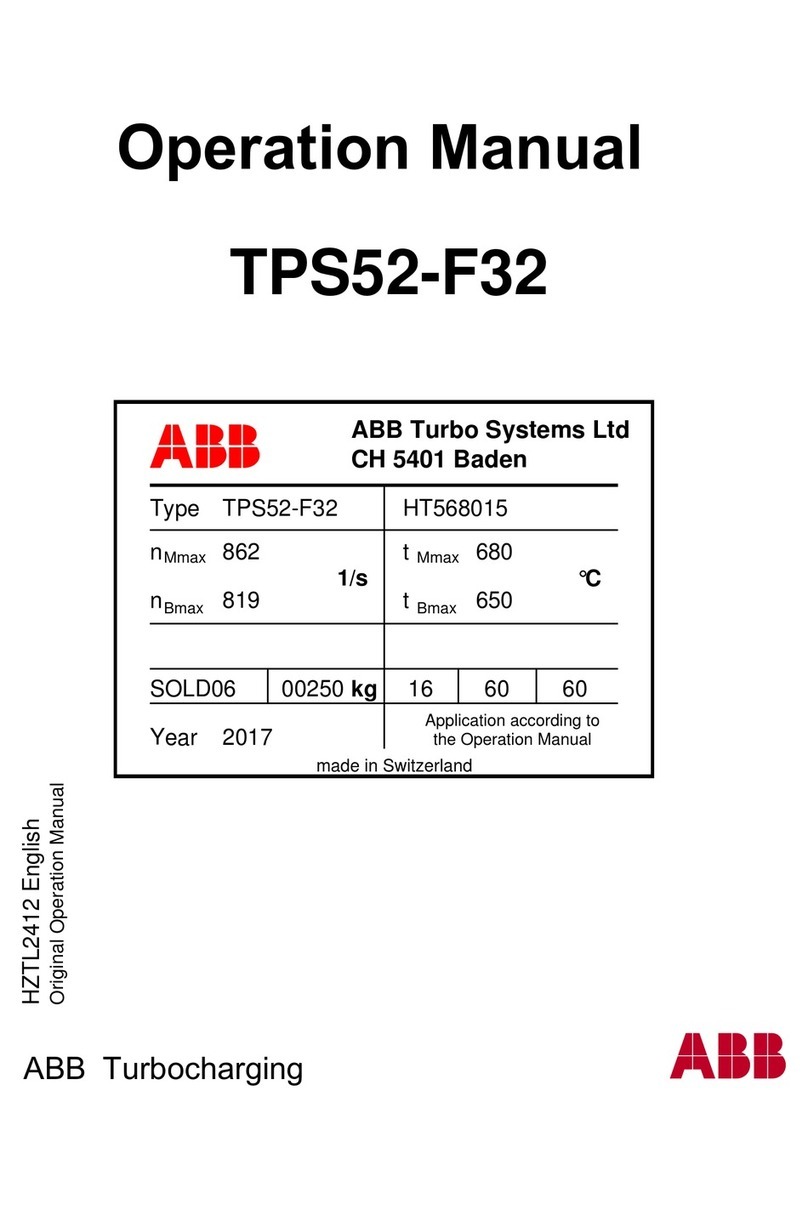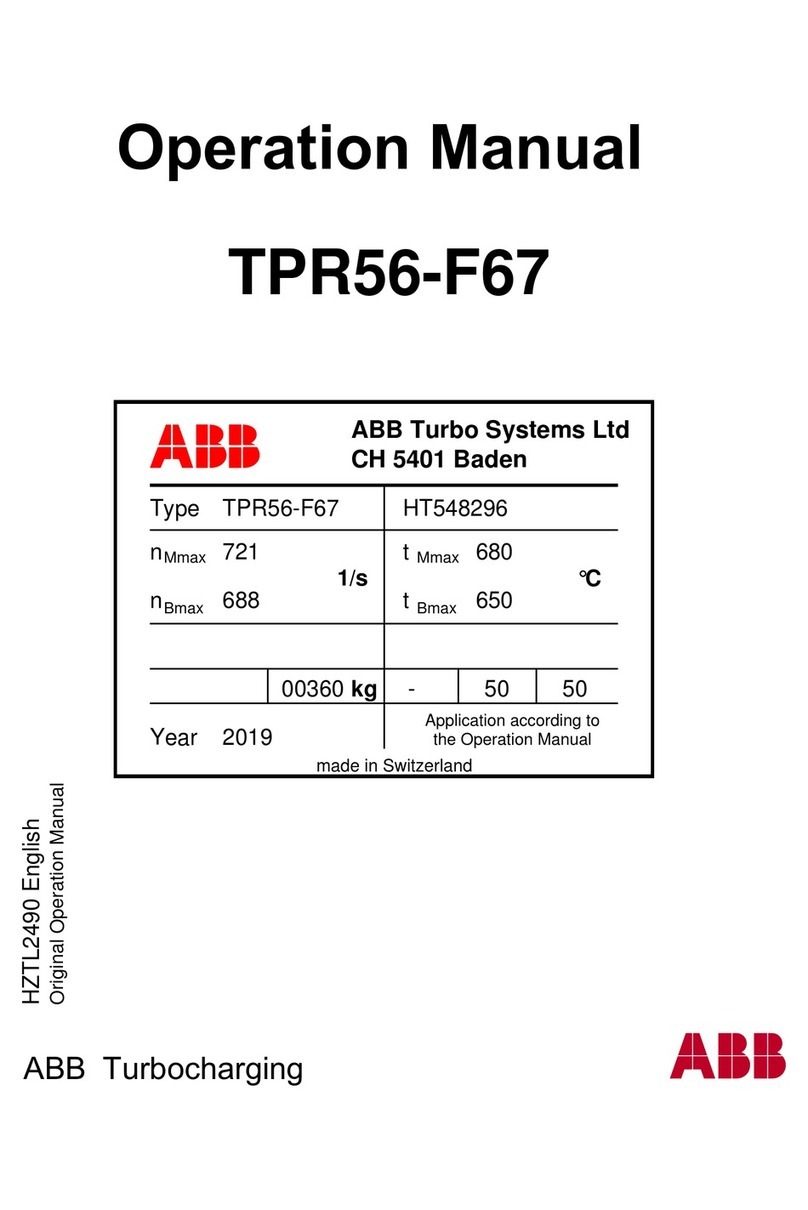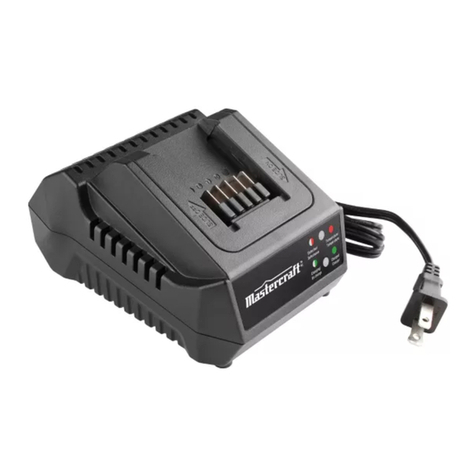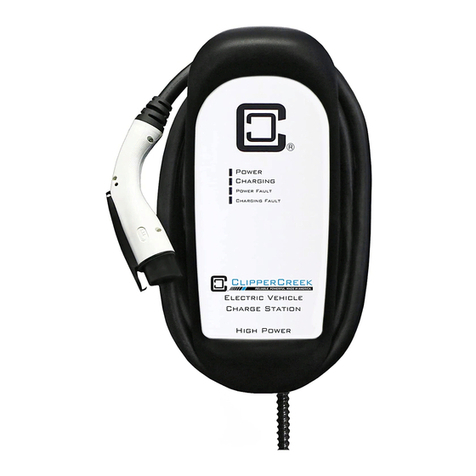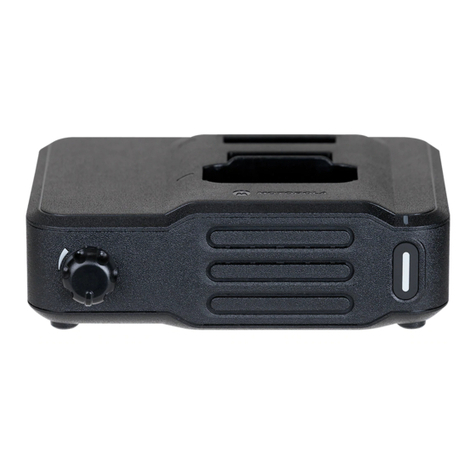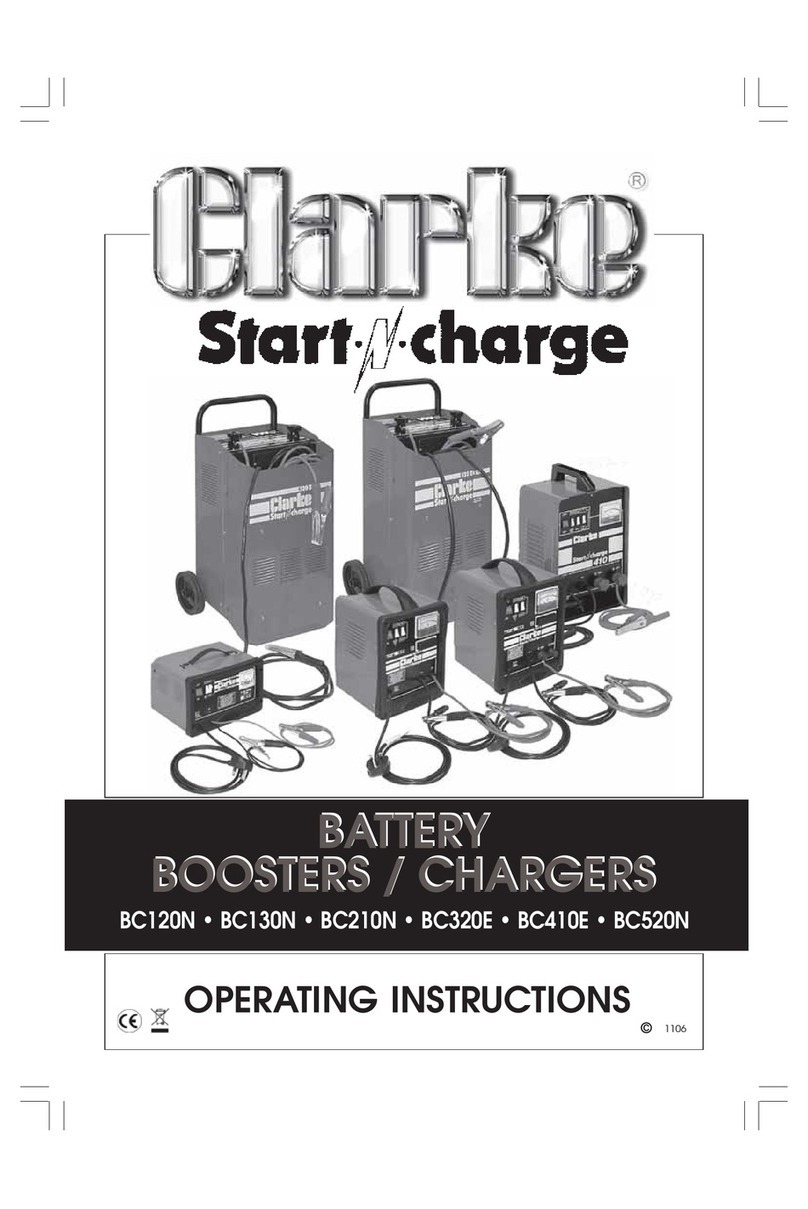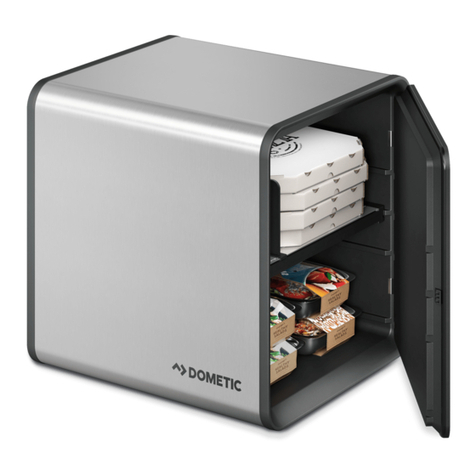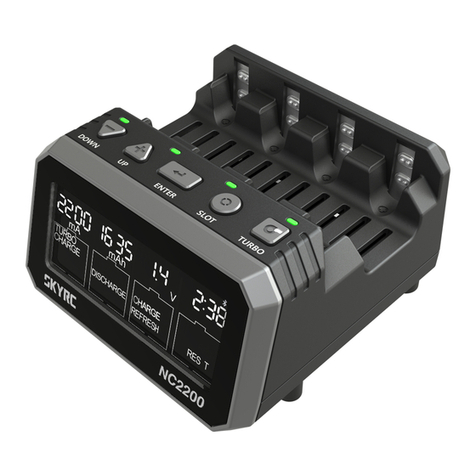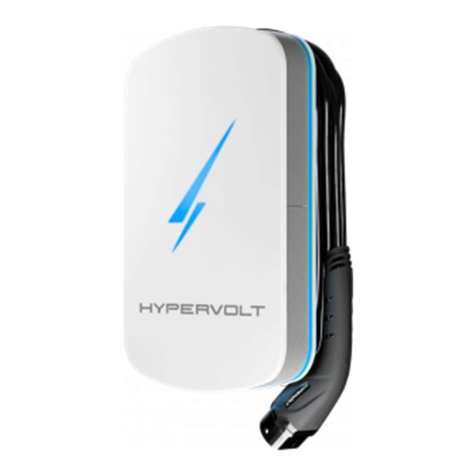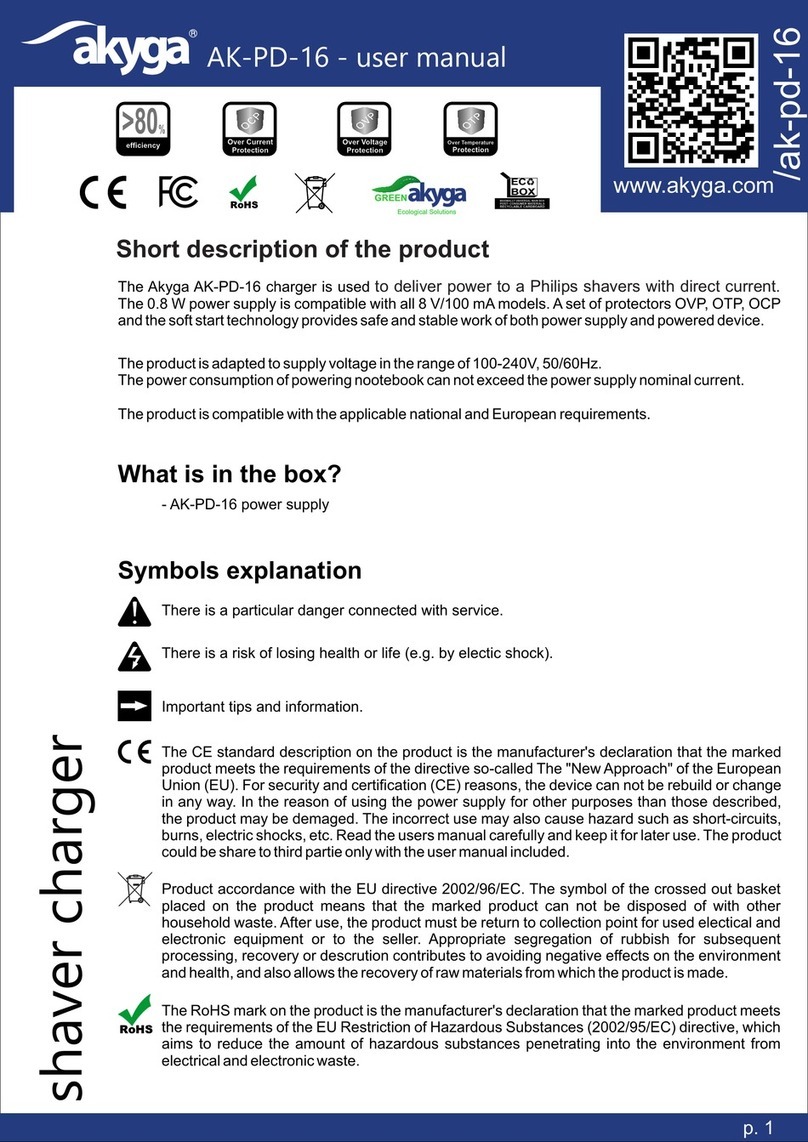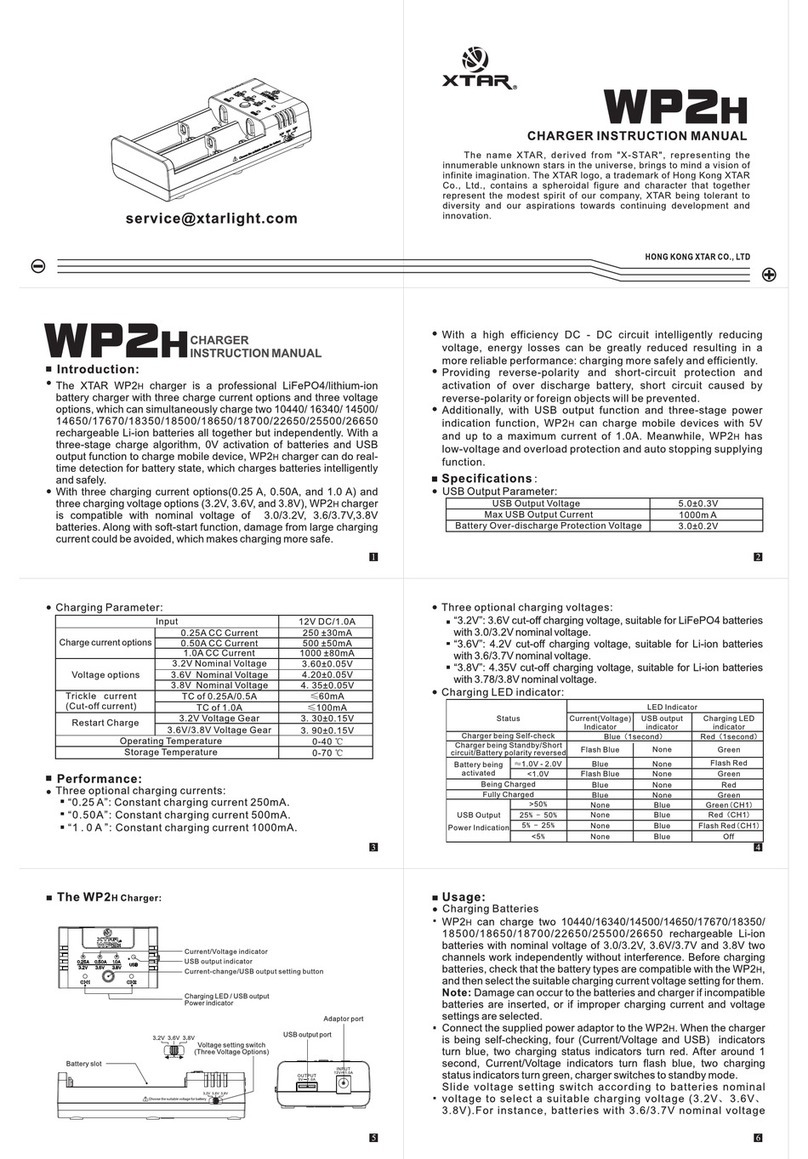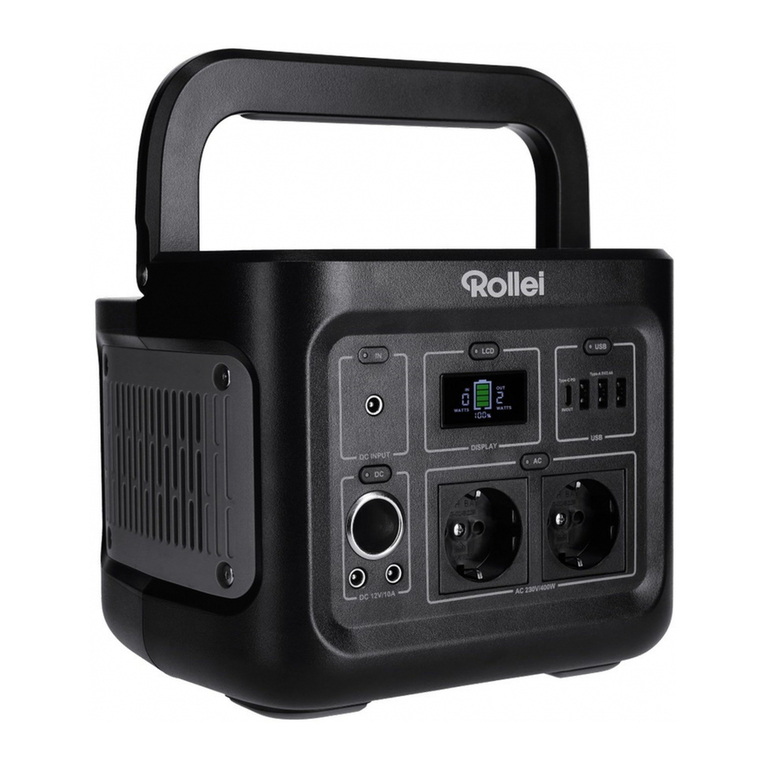ABB HVC 150P User manual

—
USER MANUAL
HVC PD Opportunity Charger
User and Operation Manual
Version 0. 4

Document: v0.4 / Document No.: 6AGA000008-0607-EN | Date: 22-05-2019 Page 2of 25
Notice
This document contains information about one or more ABB products and may include a
description of or a reference to one or more standards that may be generally relevant to the
ABB products. The presence of any such description of a standard or reference to a standard is
not a representation that all of the ABB products referenced in this document support all of the
features of the described or referenced standard. In order to determine the specific features
supported by a particular ABB product, the reader should consult the product specifications for
the particular ABB product.
ABB may have one or more patents or pending patent applications protecting the intellectual
property in the ABB products described in this document.
The information in this document is subject to change without notice and should not be
construed as a commitment by ABB. ABB assumes no responsibility for any errors that may
appear in this document.
In no event shall ABB be liable for direct, indirect, special, incidental or consequential damages
of any nature or kind arising from the use of this document, nor shall ABB be liable for incidental
or consequential damages arising from use of any software or hardware described in this
document.
This document and parts thereof must not be reproduced or copied without written permission
from ABB, and the contents thereof must not be imparted to a third party nor used for any
unauthorized purpose.
Copyrights
All rights to copyrights, registered trademarks, and trademarks reside with their respective
owners.
Copyright © 2019 ABB.
All rights reserved.

Document: v0.4 / Document No.: 6AGA000008-0607-EN | Date: 22-05-2019 Page 3of 25
Version control
Version
Date
Remarks
V0.1-0.2
01-12-2018
Released next version with pilot feedback
V0.3
01-03-2019
Released next version with updated graphics
V0.4
22-05-2019
Updated document nr and format

Document: v0.4 / Document No.: 6AGA000008-0607-EN | Date: 22-05-2019 Page 4of 25
Table of Contents
1. Introduction 6
1.1. Preface 6
1.2. Intended document users 6
1.3. Owner responsibilities 6
1.4. Signs 7
1.5. Safety regulations 8
2. Description of the product 9
2.1. Overview of the system 9
2.1.1. Power cabinet HVC 150(S) 9
2.1.2. Charge Pole 10
2.2. Description of user interface 10
2.3. Charger system configurations 10
3. Alignment of the bus 11
3.1. Tolerance position Pantograph 11
3.2. Alignment support options 12
4. Quick instruction charging 13
4.1. Instruction to the bus driver 13
4.2. Prepare for charging 13
4.3. Charging procedure starts 14
4.4. Charging procedure ends 15
4.5. Charging procedure complete 15
4.6. Power shutdown during charging 16
4.7. Emergency stop 16
4.8. Operation in the winter 17
5. Operator Instructions 18
5.1. Cleaning of the cabinet and charge pole 18
5.2. Preventive maintenance 18
5.2.1. Service inspection of the cabinets 18
5.2.2. Emergency stop inspection 19
5.2.3. Special inspections 19
5.3. Problem resolving 19
5.3.1. Overview of the Power Cabinet 19
5.3.2. Overview of the Charge pole 20
5.3.3. Component overview Power Cabinet 21
5.3.4. Component overview ACM 21
5.4. Technical functioning 22
5.4.1. Normal operation 22
5.4.2. Switch the charger system on/off 22
6. Contact information 23

Document: v0.4 / Document No.: 6AGA000008-0607-EN | Date: 22-05-2019 Page 5of 25
Glossary
AC
Alternating Current.
ACM
ACS Control Module
ACS
Automatic Control System. In this charger
system the pantograph.
CAF
Customer Acceptance Form.
Charge control set
Set of sub-system of the charger systems
which includes theACS, the control module
for the ACS, the communication unit and a
status indicator of the charge process.
DC
Direct Current.
Grid provider
Company responsible for the
transportation and distribution of electricity.
HMI
Human Machine Interface; the screen on
the charger.
HVC
Heavy Vehicle Charger.
Power Cabinet
Intermediate unit that provides 150 kW of
DC power to the Charge control set. Gets
its power from a power distribution board.
Interlock
The Interlock is an isolated current loop
and is a feature that makes the state of two
mechanisms or functions mutually
dependent.
LAN
A computer network that interconnects
computers systems within a limited area.
NOC
ABB Network Operating Centre; remotely
checks the correct functioning of the
charger.
MCB
Mechanical Circuit Breaker
OppCharge
Is a trade name of fast charging method for
electric vehicles.
Owner
The legal owner of the charger.
Pantograph
The mechanical contact linkage of the
charger through which the DC charge
power is electrical transported to the
electrical vehicle.
PE
Protective Earth.
PPE
Personal Protective Equipment. Equipment
such as safety shoes, helmet, glasses,
gloves.
RCD
Residual-Current Device.
RFID
Radio-Frequency IDentification. RFID is a
communication technology by means of
radio waves to transfer data over a very
short distance between a reader and an
electronic tag or card.
Site operator
The entity is responsible for the day to day
control of the charger. The site operator
can be the owner, but not necessarily.
User
The owner of an electric vehicle, who uses
the Charge Station to charge that vehicle.
WiFi
A technology that allows electronic devices
to connect to a wireless LAN (WLAN)
network.

1. Introduction
1.1. Preface
This guide describes the general operation and daily operator instructions for the HVC
Opportunity Charger.
The HVC Opportunity Charger is a DC fast charger system for hybrid or electrical buses that
are compatible with the OppCharge interface
1
. It is not permitted to use the HVC Opportunity
Charger to charge any other equipment, or to use the HVC Opportunity Charger for any other
purposes.
Before using the HVC Opportunity Charger, read this User and Operator Guide carefully
and attentively. Follow the instructions in this User and Operator Guide. ABB is not
responsible for any damage that has been caused by not, or incorrectly following and
executing the instruction as described in this manual.
1.2. Intended document users
This document is intended to be used by:
➢As a reference to the bus drivers of hybrid or electrical buses who will use the HVC
Opportunity Charger to (re)charge there buses.
➢As a reference for site operators who are responsible for the chargers operation on
site, performing daily inspection and maintenance activities and who are able to
perform simple trouble shooting activities, after instruction of a certified ABB
technician.
1.3. Owner responsibilities
The owner and site operator are required:
•To operate the charge system with the protective devices installed and to make sure
all protective devices are correctly installed after carrying out installation or
maintenance.
•To write an emergency plan that instructs people what to do in case of emergency.
•To prepare the site where the charge system will be installed, according to the
requirements described in this guide.
•To make sure that there is enough space around the charger to carry out maintenance
work.
•To appoint a person responsible for the safe operation of the charge station and for
the coordination of all work.
The owner of the charger is warned that changes or modifications that are not explicitly
approved by ABB could void the owner’s authority to operate the equipment or ABB’s
warranty.
Neither ABB nor its affiliates shall be liable to the purchaser of this product or third parties for
damages, losses, costs or expenses incurred by purchaser or third parties as a result of: an
accident, misuse or abuse of this product or unauthorized modifications, repairs or alterations
to this product, or failure to strictly comply ABB operating and maintenance instructions.
1
More information on OppCharge via www.oppcharge.org.

Document: v0.4 / Document No.: 6AGA000008-0607-EN | Date: 22-05-2019 Page 7of 25
1.4. Signs
The following signs are used on the equipment and in this manual:
DANGER
Hazardous voltage
Identifies a hazard that could result in severe injury or death through
electrocution.
WARNING
Various
Identifies a hazard that could result in severe injury or death.
WARNING
Rotating parts
Identifies a hazard that could result in injury due to the presence of
rotating or moving parts.
WARNING
Pinch Hazard
Identifies a hazard that could result in injuries in which some body parts
are pinched or crushed.
WARNING
Fall Hazard
Identifies a hazard that could result in injury due unsafe work at height.
CAUTION
Various
Identifies a hazard that could result in damage to the machine, other
equipment, and/or environmental pollution.
CAUTION
Environmental damage
Identifies a special indications as well as biddings and prohibitions to
avoid damages in the environment. This sign refer to present national
regulation according the environment.
NOTICE
Contains remarks, suggestions or advice.

Document: v0.4 / Document No.: 6AGA000008-0607-EN | Date: 22-05-2019 Page 8of 25
1.5. Safety regulations
WARNING
If the pantograph is damaged, take the following steps:
1. Do not use the charge system.
2. Contact the owner / site operator.
WARNING
If there is an emergency:
1. Push the emergency stop.
2. Contact the owner / site operator.
3. Act according to the emergency procedure of the owner / site
operator.
WARNING
Operation after damage or accidents:
•If there is a fire in or nearby the charger;
•If the charger was immersed in water, or any other fluid;
•If the charger is damaged in any way.
Do not use the charger. Contact the owner / site operator.

Document: v0.4 / Document No.: 6AGA000008-0607-EN | Date: 22-05-2019 Page 9of 25
2. Description of the product
2.1. Overview of the system
A Low voltage power distribution cabinet of the owner
B Charge Pole with ACM and Pantograph
C Power Cabinet(s)
D Electric hybrid and/or full electric bus
E Bus stop space for Opportunity Charging (OppCharge)
2.1.1. Power cabinet HVC 150 (S)
A Door
B Door handle / lock
C 3G Antenna
D Air inlets (also on the left and back side)
E Air outlet
CAUTION
The Power Cabinet has air inlets (D) and an air outlet (E) to control the
temperature inside the cabinet. Do not install or place any objects near
or against these air inlets and outlet. If necessary, take precautions to
prevent snow or any other objects from blocking the air inlets and outlet.

Document: v0.4 / Document No.: 6AGA000008-0607-EN | Date: 22-05-2019 Page 10 of 25
2.1.2. Charge Pole
A Door to ACM
B Emergency button
C Charge state indicator light (beacon)
D Distance sensor
E Pantograph
F WiFi communication unit
G RFID unit (if installed, optional)
2.2. Description of user interface
There are three indicator lights (C) at the Charge Pole that serve as an information for the bus
driver:
Color
State
Charge status
Continuous
Ready to charge
Blinking
Initializing
Continuous
Charge complete
Blinking
Charging
Continuous
Error
Under the beacon (C) there is a red Emergency button (B). This Emergency button can be
used only in an emergency situation. When pushing this Emergency button it will immediately
stop the charging process and cut off the DC power from the charger. See also section
Emergency stop on page 16.
2.3. Charger system configurations
The HVC Opportunity Charger is built up with a modular architecture. There are three HVC
Opportunity Charger systems available, depending on the DC output power:
Charger system
Power Cabinet(s)
DC output power
HVC 150P Opportunity
Charger
HVC 150
150 kW
HVC 300P Opportunity
Charger
HVC 150 and HVC 150S
300 kW
HVC 450P Opportunity
Charger
HVC 150 and 2x HVC 150S
450 kW

Document: v0.4 / Document No.: 6AGA000008-0607-EN | Date: 22-05-2019 Page 11 of 25
3. Alignment of the bus
It is important that the Pantograph is in the right position in relation to the bus, so that the
Pantograph can make good physical contact with the power charge connection rails on the
roof of the bus.
For most electric hybrid and/or full electric bus, the front wheelbase is exactly below the power
charge connection rails on the roof of the bus. Check the technical specifications of the used
electric hybrid / full electric bus for the correct position of the power charge connection rails.
Reference position of the connection rails directly above the front wheelbase.
3.1. Tolerance position Pantograph
In general the bus has a certain freedom degree to position under the Pantograph:
➢Driving direction: +/- 300 mm, 600 mm in total;
➢Sideways: +/- 250 mm, 500 mm in total;
➢Height: 1600 mm.

Document: v0.4 / Document No.: 6AGA000008-0607-EN | Date: 22-05-2019 Page 12 of 25
3.2. Alignment support options
Standard advice to support the alignment between the bus and the Pantograph is to apply
white lines at the bus stop to instruct the bus driver where to stop, see picture below as an
example.
Additional alignment options are shown below:
NOTICE
There are special manuals available that describe alignment options for
specific hybrid and electric bus types. Contact your local ABB sales
department for request of this manual.

Document: v0.4 / Document No.: 6AGA000008-0607-EN | Date: 22-05-2019 Page 13 of 25
4. Quick instruction charging
NOTICE
Always read the operating instructions of the used electric hybrid and/or
full electric bus when using the HVC Opportunity Charger.
4.1. Instruction to the bus driver
1. Information provided by the bus
Information display in the bus
Live feed of the charge status
Example display in the bus (depends
on the bus OEM and type)
2. Information provided by the charger
Indicator lights (beacon) on the charge pole
Visible from the driver’s seat
Indicating the charge process with different colors,
see section Description of user interface on page 10
View from the driver on the beacon
4.2. Prepare for charging
Bus arrives at stop for charging.
Wi-Fi communication starts between the charger and the bus.

Document: v0.4 / Document No.: 6AGA000008-0607-EN | Date: 22-05-2019 Page 14 of 25
The driver aligns the bus according to the lines on the road or by one of the other alignment
options (see section Alignment of the bus on page 11).
The driver indicates the readiness to start charging by applying the handbrake.
4.3. Charging procedure starts
Pantograph comes down automatically. Time between applying the handbrake (initiate cycle)
and start charging is between 15-30 seconds, depending on integration at the bus side.
PE and safety check (continuous) is performed between the bus and the charger.
➢When safety check is positive: start of power flow.
➢When safety check is negative: Pantograph goes up automatically and bus driver
receives a notification on the dashboard (e.g. when the positioning of the bus is not
correct).
Status during charging can be checked by reading out the dashboard display in the bus or by
looking at the charge status indicator light (beacon) on the charge pole (see section
Description of user interface on page 10).

Document: v0.4 / Document No.: 6AGA000008-0607-EN | Date: 22-05-2019 Page 15 of 25
During charging the charging process can be interrupted at any time by releasing the
handbrake.
4.4. Charging procedure ends
Bus driver sees that the charge progress is complete or he/she has to interrupt the charging
process to continue the operation.
Bus driver indicates readiness by releasing the handbrake.
Pantograph goes up automatically. Time between bus indication a stop charge (release
handbrake) until clearance to drive away is 5 seconds.
4.5. Charging procedure complete
Sensors will check if the pantograph is up and send a confirmation to the bus.
Bus driver receives OK signal on the dashboard.
Bus driver drives away.

Document: v0.4 / Document No.: 6AGA000008-0607-EN | Date: 22-05-2019 Page 16 of 25
4.6. Power shutdown during charging
The Pantograph will return to its idle position when the supply is turned off. Due to power
shutdown there is no communication possible between the bus and the charger. Therefore
the bus will not get the OK signal fromthe charger indicating that the Pantograph is completely
lifted. As a result the bus cannot drive away until:
➢The bus driver reset the bus (this is dependent on the bus OEM, read the operating
instructions of the bus);
➢The bus driver waits until the power is back on and the bus receives the OK signal.
4.7. Emergency stop
If there is an emergency:
1. Push the emergency stop button (B).
The charger stops immediately the charging process and cut off the DC
power from the charger.
NOTICE
The emergency stop button does not disconnect the charger system from
the mains voltage! This emergency stop button disconnect only the DC
power voltage lines, the control of the charger are still operational.
2. Contact the Site operator.
NOTICE
Emergency button is pressed accidentally
If the emergency stop button is accidentally pushed:
1. Verify the situation is safe.
2. Turn the emergency stop button clockwise.
•The emergency button is released and the charger is reactivated.
•After a few seconds the charger returns to normal operation.

Document: v0.4 / Document No.: 6AGA000008-0607-EN | Date: 22-05-2019 Page 17 of 25
4.8. Operation in the winter
Charger side
To support the operation in the winter the contact strips of the Pantograph are equipped with
a heating unit designed for de-icing the contact strips. Power rating is 60 W.
Bus side
To support operation in the winter, the rails are equipped with a heating unit that is designed
for de-icing the rail.
Additional measures:
➢Park the buses inside or under a roof during the night;
➢If parked outside, remove the snow from the top of the bus before start of operation;
➢Additional heating unit surrounding the rails on top of the bus (not part of the ABB
offering).

Document: v0.4 / Document No.: 6AGA000008-0607-EN | Date: 22-05-2019 Page 18 of 25
5. Operator Instructions
5.1. Cleaning of the cabinet and charge pole
DANGER
Electrical components
•Do not apply high-pressure water jets. Water may leak into the
cabinet.
•Only use cleaning agents with a pH value between 6 and 8.
•Do not use cleaning agents with abrasive components.
•Do not use abrasive tools.
The cabinet of the Power Cabinet and Charge pole is made from powder coated high quality
stainless steel. The coating must be kept in good condition.
Clean the Charger three times a year in the following way:
•Remove rough dirt by rinsing with low-pressure tap water.
•Apply a neutral or weak alkaline cleaning solution and let it soak.
•Remove dirt by hand with a non-woven nylon hand pad.
•Rinse thoroughly with tap water.
•Optionally, apply wax on the front for extra protection and gloss.
•Check the coating on damage.
NOTICE
Rust forming
When the charger is placed in a corrosion sensitive environment, the
forming of superficial rust is possible on the welding points on the side
grills. This rust is merely visual, there is no possibility this will form a risk
on the cabinets integrity.
The rust can be removed with the cleaning procedure above. To prevent
the rust from reappearing; prime the areas with a transparent or color-
like priming finish.
5.2. Preventive maintenance
Maintenance is done according the maintenance schedule. The charger must be inspected
and serviced yearly by a certified technician.
5.2.1. Service inspection of the cabinets
The following points must be checked regularly:
•Internal RCDs and RCBOs need tobe tested on correct functioning ona regular basis.
During the yearly maintenance round that is advised to be executed by a certified ABB
technician, this will be checked.
•Powder coating: look for damage, cracks or ruptures.

Document: v0.4 / Document No.: 6AGA000008-0607-EN | Date: 22-05-2019 Page 19 of 25
5.2.2. Emergency stop inspection
It is advised to test the emergency button every time someone of the operator or service
organization visits the location of the charger. This test needs to be done at least once a year
e.g. during a preventive maintenance round.
Test only when the charger is in idle mode and ready to charge:
1. Press the emergency button.
•The indicator light (beacon) will turn red.
2. Reset the emergency button by turning the knob clockwise.
•After a few moments, the charger returns to its idle state.
5.2.3. Special inspections
In the following cases the charger must be checked by ABB service personnel before further
use:
•If it was struck by lightning.
•If it is damaged due to an accident or fire.
•If its location has been flooded.
5.3. Problem resolving
The site operator or helpdesk is the first response to a customer call. The helpdesk can
remotely solve simple problems for the customer.
In special cases the site operator with knowledge of the charger can be asked by ABB support
to report about the status of some internal components of the charger. Therefore a brief
description of the position and function of these components is described on the next pages.
5.3.1. Overview of the Power Cabinet
A Door
B Door handle / lock (per Power Cabinet
Unique system key)
WARNING
Do not open the Power Cabinet door if you are not familiar with working
with high voltage and high current.

Document: v0.4 / Document No.: 6AGA000008-0607-EN | Date: 22-05-2019 Page 20 of 25
5.3.2. Overview of the Charge pole
A Front door Charge pole
B Cylinder locks (3x) (per Charge pole unique system key)
C Door ACM
D Locks (2x) (square key)
WARNING
Do not open the Charge pole and ACM door if you are not familiar with
working with high voltage and high current.
This manual suits for next models
3
Table of contents
Other ABB Batteries Charger manuals
